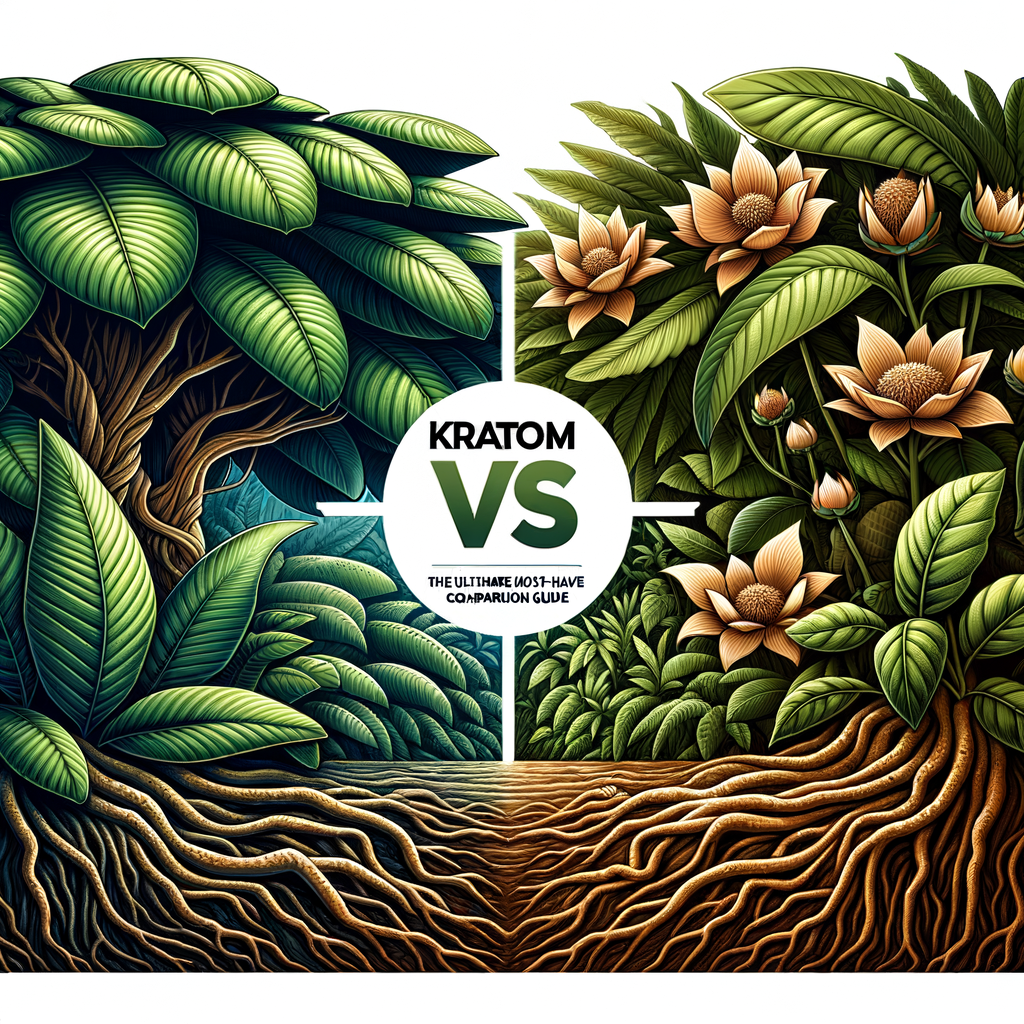
Kratom vs Kava: The Ultimate Must-Have Comparison Guide
- Understanding Kratom and Kava: Origins and Uses
- The Roots of Kratom
- The Backstory of Kava
- Comparing Effects: Kratom vs. Kava
- Kratom Effects
- Kava Effects
- Safety and Side Effects: What to Know
- Kratom Safety Concerns
- Kava Safety Concerns
- Legal Status: Navigating Regulations
- Kratom Legality
- Kava Legality
- Choosing Between Kratom and Kava
- Consider Your Goals
- Making an Informed Choice
- User Experiences: What People Are Saying
- Kratom Testimonials
- Kava Testimonials
- Tips for Responsible Use
- Frequently Asked Questions (FAQs)
- 1. What is the main difference between Kratom and Kava?
- 2. Can you mix Kratom and Kava?
- 3. How long do the effects of Kratom last?
- 4. Is Kava safe for everyone?
- 5. Where can I buy Kratom and Kava safely?
- 6. How should I prepare Kava for consumption?
- 7. What are the legal restrictions for Kratom in my area?
- 8. What should I do if I experience side effects from either substance?
- 9. Can I build a tolerance to Kratom or Kava?
- 10. What should I look for when choosing Kratom or Kava products?
- References
Understanding Kratom and Kava: Origins and Uses

When it comes to natural remedies, few topics spark as much interest as Kratom and Kava. Both have deep-rooted cultural significance and unique effects. Understanding the origins and uses of each can help you make an informed choice.
The Roots of Kratom
Kratom, or Mitragyna speciosa, hails from Southeast Asia. People have used it for centuries in countries like Thailand and Indonesia. Traditionally, locals chewed the leaves for their stimulant and analgesic properties. It’s important to note that Kratom can produce a range of effects depending on the dosage. Lower doses tend to offer energy and alertness, while higher doses might induce sedation.
In recent years, Kratom has gained popularity in Western countries. Users often seek it for pain relief, mood enhancement, and energy boosting. However, its legal status remains complex; some states have banned it while others embrace its use. If you’re considering trying Kratom, it’s wise to educate yourself about local regulations.
The Backstory of Kava
Kava, or Piper methysticum, originates from the South Pacific. People have used Kava in ceremonies and social gatherings for centuries. The roots of the Kava plant are ground into a powder and mixed with water to create a beverage. This drink has a calming, relaxing effect, making it popular in various cultures for easing anxiety and promoting social interaction.
Like Kratom, Kava is also making waves in Western markets. Users appreciate its soothing effects, often seeking it out as a natural alternative to alcohol or anti-anxiety medications. However, not all Kava products are created equal. The preparation method and strain can significantly affect its potency and effects.
Comparing Effects: Kratom vs. Kava
Understanding the effects of Kratom and Kava is crucial for choosing the right one for you. Each has its own profile, uses, and potential side effects.
Kratom Effects
– Stimulant or Sedative: As mentioned earlier, the effects of Kratom depend on the dosage. At low doses, it can boost energy and alertness. At high doses, it may offer pain relief and sedation.
– Pain Relief: Many users turn to Kratom for its analgesic properties. Those suffering from chronic pain conditions often report significant relief.
– Mood Enhancement: Some people experience elevated mood and sociability. Kratom can offer a sense of well-being, making it appealing for those facing anxiety or depression.
Kava Effects
– Relaxation and Calmness: Kava primarily promotes relaxation without impairing cognitive function. Users typically feel more social and less anxious.
– Muscle Relaxation: Kava may also help relieve muscle tension. Many people find it effective after a long day at work or after physical activity.
– Improved Sleep Quality: Some users report better sleep after consuming Kava. It can help those suffering from insomnia or restlessness find a peaceful night’s rest.
Safety and Side Effects: What to Know
Both Kratom and Kava have potential side effects and safety concerns. It’s essential to weigh these risks against the benefits when considering use.
Kratom Safety Concerns
– Dependence and Addiction: Regular use of Kratom can lead to dependence. Users often experience withdrawal symptoms if they stop suddenly.
– Potential Side Effects: Some common side effects include nausea, constipation, and dizziness. Users should be cautious, especially at higher doses.
– Interaction with Other Substances: Kratom can interact negatively with other medications. Always consult with a healthcare professional before mixing it with other substances.
Kava Safety Concerns
– Liver Health Risks: Some studies suggest that Kava may affect liver health. Users should be aware of any existing liver conditions and consult their doctor.
– Potential for Overconsumption: Drinking too much Kava can lead to adverse effects like drowsiness and nausea. Moderation is key.
– Interaction with Medications: Kava can interact with certain medications, especially those that affect the central nervous system. Always seek medical advice before use.
Legal Status: Navigating Regulations
The legal status of Kratom and Kava varies significantly around the world. Understanding the laws can keep you out of trouble.
Kratom Legality
– United States: The legal status of Kratom varies by state. While it’s legal in some places, states like Alabama and Indiana have banned it completely. Always check local laws.
– Internationally: Countries such as Australia and New Zealand have strict regulations or bans against Kratom. Understanding the international landscape can help you navigate travel or online purchases.
Kava Legality
– United States: Kava is generally legal in the U.S., but it is subject to scrutiny over safety concerns. Some states have limitations regarding its sale.
– Internationally: Kava is widely accepted in many Pacific Island nations. However, countries like Canada have placed restrictions on its use.
Choosing Between Kratom and Kava
Deciding between Kratom and Kava ultimately depends on personal preferences and health needs. Both offer unique benefits, but understanding your goals is crucial.
Consider Your Goals
1. Energy vs. Relaxation: If you seek an energy boost or pain relief, Kratom might be your best option. On the other hand, if relaxation and social interaction are your priorities, Kava could be a better fit.
2. Potential Side Effects: Examine any medications you take. Kratom and Kava can interact with various drugs, so always consult a healthcare professional.
3. Cultural Context: If you appreciate cultural experiences, Kava offers a deep-rooted connection to Pacific Island traditions.
Making an Informed Choice
To make a wise choice, consider starting with smaller doses of either. Monitor how your body responds before increasing your intake. Journaling your experiences can also help track effects, enabling you to find what works best for you.
User Experiences: What People Are Saying
The best way to gauge which substance may suit you is to look at user experiences. These anecdotes can provide valuable insights and guidance.
Kratom Testimonials
Many Kratom users report noticeable improvements in their daily lives. Some highlight its ability to alleviate chronic pain, allowing them to engage in activities they enjoy. Others appreciate its uplifting qualities and report a more positive state of mind.
Kava Testimonials
Kava users often share experiences centered around social interactions and relaxation. Many find that they feel more comfortable in social settings. Others highlight its role in supporting peaceful sleep.
Tips for Responsible Use
Regardless of whether you choose Kratom or Kava, responsible use is key. Consider these tips:
– Research Thoroughly: Knowledge is power. Understand the strains, effects, and preparation methods of both substances.
– Start Low, Go Slow: Begin with a low dosage to assess tolerance. Gradually increase it as needed, but never rush your experience.
– Stay Hydrated: Especially with Kava, staying hydrated can mitigate some potential side effects.
– Listen to Your Body: Pay attention to how your body reacts. If you feel adverse effects, don’t hesitate to reduce your intake or stop altogether.
Frequently Asked Questions (FAQs)
1. What is the main difference between Kratom and Kava?
Kratom is primarily used for energy and pain relief, while Kava is known for its relaxing and calming effects.
2. Can you mix Kratom and Kava?
It’s generally not recommended to mix Kratom and Kava due to their contrasting effects and potential for negative interactions.
3. How long do the effects of Kratom last?
The effects of Kratom can vary, generally lasting between 2 to 6 hours, depending on the dosage and individual metabolism.
4. Is Kava safe for everyone?
While many people can use Kava safely, it may not be suitable for those with liver conditions or pregnant women.
5. Where can I buy Kratom and Kava safely?
Always seek out reputable vendors that provide third-party lab testing for quality assurance. Online forums and reviews can help guide your choice.
6. How should I prepare Kava for consumption?
Kava is typically prepared by mixing the powdered root with water and straining it. There are also various pre-made Kava products available.
7. What are the legal restrictions for Kratom in my area?
The legality of Kratom varies by state and country. Always check local regulations before purchasing or using it.
8. What should I do if I experience side effects from either substance?
If you encounter side effects, discontinue use immediately and consult a healthcare professional for advice.
9. Can I build a tolerance to Kratom or Kava?
Yes, with regular use, you may build a tolerance. This can lead to needing higher doses for the same effects.
10. What should I look for when choosing Kratom or Kava products?
Choose high-quality products from reputable sources, ensuring they are lab-tested and free of harmful additives.
References
– National Center for Complementary and Integrative Health. (n.d.). Kratom. Retrieved from NCCIH
– Mayo Clinic. (2021). Kava extract: An overview of the safety and efficacy. Retrieved from Mayo Clinic
– American Herbal Products Association. (2020). Kava – An overview of its uses and safety. Retrieved from AHPA


